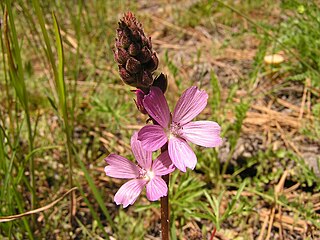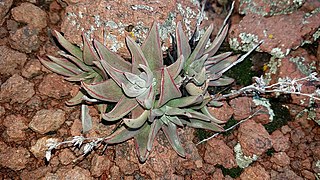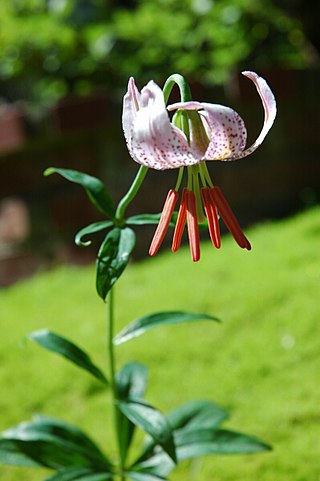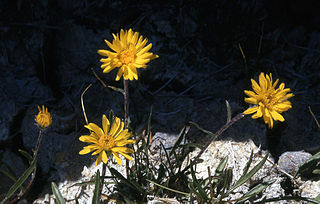
Sidalcea pedata, also called birdfoot checkerbloom or Big Bear checkerbloom, is a rare and endangered perennial herb of California. It blooms between May and July. However, it is an endemic species of California and only occurs in few places in the San Bernardino Mountains, primarily at Bear Valley, Bluff Lake. It grows at 1500–2100 m elevation in moist meadows to open woodlands and the unique pebble plain habitat of the area. Since Big Bear Valley is a resort destination, the birdfoot checkerbloom is threatened by development, vehicles and grazing.

Cirsium occidentale, with the common name cobweb thistle or cobwebby thistle, is a North American species of thistle in the family Asteraceae.

Astragalus albens is a species of milkvetch known by the common names Cushenbury milkvetch and silvery-white milkvetch.

Astragalus jaegerianus is a rare species of milkvetch known by the common name Lane Mountain milkvetch. The plant was named for the biologist Edmund Jaeger, who first documented it in 1939.

Calochortus nudus is a North American species of flowering plant in the lily family known by the common name naked mariposa lily.

Dudleya abramsii is a species complex of succulent plants native to California and parts of Baja California. There are numerous subspecies, some critically endangered, with varying habits and lifestyles, but most often characterized by a smaller size, yellow flowers, and an affinity for rocky habitats. The subspecies may be polyphyletic.

Linanthus maculatus is a species of flowering plant in the phlox family known by the common names San Bernardino Mountain gilia and Little San Bernardino Mountains gilia. It is endemic to California, where it is known only from a few locales in the Little San Bernardino Mountains and the adjacent Palm Springs area in the northern end of the Coachella Valley. The largest populations, which may contain thousands of individuals, are located within the bounds of Joshua Tree National Park. This is a very small annual herb no more than three centimeters high. It has a taproot which may exceed 6 centimeters in length to collect moisture from the dry desert sand in its native habitat. The tiny, hairy stem branches to form small matted clusters on the sand surface. The hairy leaves are just a few millimeters long and unlobed. The inflorescence is a dense cluster of flowers each only 2 to 5 millimeters wide. The flower corolla has curled-back lobes which are white, sometimes with a spot of purple or pink. The protruding stamens are yellow. The main threat to this species is development in its range, and it is also vulnerable to off-road vehicle damage in the wide open sandy flats where it grows.

Lilium kelloggii is a species of lily known by the common name Kellogg's lily. It is endemic to the Klamath Mountains of northwestern California and southwestern Oregon, where it grows in forests, including those dominated by redwoods.
Linanthus killipii, known by the common name Baldwin Lake linanthus, is a rare species of flowering plant in the phlox family.
Linanthus orcuttii is an uncommon species of flowering plant in the phlox family known by the common name Orcutt's linanthus. It is known only from southern California and Baja California, where it grows in chaparral and pine forests in the Peninsular Ranges and occasionally the San Bernardino Mountains.
Monolopia stricta is a species of flowering plant in the family Asteraceae known by the common name Crum's monolopia. It is endemic to central California, where it grows in the Central Valley and its flanking mountain ranges and foothills. It open grasslands and chaparral, often in clay soils. It is an annual herb producing a slender, sometimes branching stem up to about 80 centimeters tall. It is usually somewhat woolly in texture. The inflorescences at the ends of stem branches bear small hemispheric flower heads. The golden ray florets are usually about 1 to 2 centimeters long, but specimens from the western San Joaquin Valley have smaller florets.

Navarretia heterodoxa is a species of flowering plant in the phlox family known by the common name Calistoga pincushionplant. It is endemic to the San Francisco Bay Area in California, where it grows in the serpentine soils of the hills and mountains.

Penstemon spectabilis is a species of penstemon known by the common name showy penstemon or showy beardtongue. It is native to southern California and Baja California, where it grows in the chaparral, scrub, and woodlands of the coastal mountain ranges.

Phlox austromontana is a species of phlox known by the common name mountain phlox. It is native to the southwestern United States and Baja California, where it grows in forested and wooded mountain habitat, scrub, and open areas. It is a mat-forming perennial herb growing in patches of very short stems. The lance-shaped leaves are no more than 1.5 centimeters long and are arranged oppositely in pairs on the short stems. The inflorescence is a solitary flower at the tip of each stem. The flower is white or light pink or lavender with five rounded lobes. It is just over a centimeter long.

Phlox diffusa is a species of phlox known by the common name spreading phlox. It is native to western North America from British Columbia to the southwestern United States to the Dakotas, where it grows in many types of habitat, including rocky, high elevation mountain slopes. It is a very compact mat-forming perennial herb growing in cushions or patches of short, decumbent stems. The linear, lance-shaped, or needle-like leaves are no more than 1.5 centimeters long and are oppositely arranged in bundles on the short stems. The inflorescence is a solitary tubular flower around a centimeter long. It has a flat white or pale pink or blue corolla with five lobes each just under a centimeter in length.

Microsteris is a monotypic genus of flowering plants in the phlox family containing the single species Microsteris gracilis, known by the common name slender phlox.

Psorothamnus arborescens is a species of flowering plant in the legume family known by the common name Mojave indigo bush.

Pyrrocoma uniflora is a species of flowering plant in the family Asteraceae known by the common name plantain goldenweed. It is native to western North America from central Canada to California to Colorado, where it grows in several types of habitat, including forest and meadows with alkali soils, such as those near hot springs. It is a perennial herb growing up to 40 centimeters tall, the stems reddish and usually with a thin to thick coating of woolly fibers. The lance-shaped, toothed leaves are usually woolly, the largest near the base of the plant reaching up to 12 centimeters in length. The inflorescence is a single flower head or a cluster of a few heads, each lined with woolly phyllaries. The head contains yellow disc and ray florets. The fruit is an achene which may be over a centimeter long including its long pappus.

Thelypodium stenopetalum is a rare species of flowering plant in the mustard family known by the common names slenderpetal thelypody, slender-petaled thelypodium and slender-petaled mustard. It is endemic to the San Bernardino Mountains of southern California, where it is known from only three or four extant occurrences in moist mountain meadows near Big Bear Lake. Its remaining habitat is considered seriously threatened and the plant is a federally listed endangered species in the United States.

Physaria kingii is a species of flowering plant in the family Brassicaceae known by the common name King bladderpod. It is native to western North America from Utah to Baja California, where it grows in dry and rocky habitat, such as deserts and adjacent mountain slopes. This is a perennial herb growing a small, hairy stem from a caudex. The leaves form a patch or rosette around the caudex, each up to 6 centimeters long and round, oval, diamond, or spoonlike in shape. The inflorescence is an erect or mostly upright raceme of bright yellow mustardlike flowers. The fruit is a hairy capsule under a centimeter long suspended on a short, often curvy pedicel.

















